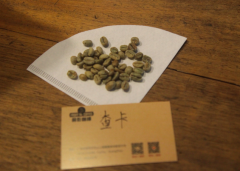Description of flavor characteristics of Peruvian coffee beans and planting conditions of Peruvian coffee producing area
Peruvian coffee, famous for its organic coffee. Peru (Spanish: Per ú; Quechua, Aymara: Piruw), the full name of the Republic of Peru (Spanish: Rep ú blica del Per ú), is a country in western South America.
Flavor and taste characteristics: high quality and balanced, palatable acidity, can be used for mixed coffee
Peru is a coffee-rich country-only 10% of Arabica coffee can be called boutique coffee. The plateau climate brought by high altitude, as well as suitable temperature, air, light and fertile soil, these unique geographical advantages prolong the growing period of coffee beans and provide perfect conditions for growing delicious and fragrant Arabica coffee beans.
Peru is also the second largest producer of organic coffee in the world. The mineral-rich organic soil, coupled with a small farm model, insists on using natural fertilizers instead of chemical fertilizers, picking and selecting by hand, making the quality of Peruvian organic coffee better and better.
As a fragile organic crop, coffee is born to grow in shade in order to slow down growth, reduce irrigation water and prevent soil erosion. In Peru, farmers use shade-grown shade to bring coffee back to nature, while allowing insects and birds to live here.
Peruvian small farmers know better than anyone the importance of sustainable cultivation, so Peruvian coffee has been certified by a number of sustainable standards to protect healthy rainforests, animal and plant ecology, rivers and land. It can be said that under the premise of ensuring a good taste, Peruvian coffee also represents healthy, sustainable and environmentally friendly.
Peru (Peru) is also a big coffee producer. Up to 98% of Peruvian coffee is grown in forest areas, and most producers are small farmers.
Peru has good economic conditions and a stable political situation, thus ensuring the good quality of coffee. However, there are many local problems, in addition to guerrilla warfare and drug trafficking, the emergence of cholera along the coast in the mid-1990s led to a further economic depression, and what is more, the annual inflation rate reached 7000%.
In the mid-1970s, Peruvian coffee production was about 900000 bags a year, and then steadily increased to about 1.3 million bags a year. Although private exporters buy coffee in remote areas through middlemen, the main market is still monopolized by the government. Later, the private Peruvian Coffee exporters Association (Comera de Exportadores deCafe del Peru) was established, which is committed to improving the quality of coffee. Its primary task is to set standards and eliminate inferior products, so as to create an atmosphere of quality supremacy.
Peru's finest coffee is produced in Chanchmayo, Cuzco, Norte and Puno. Most Peruvian coffee is grown under natural conditions, but it is also difficult to confirm the cultivation of all coffee trees. The price of coffee grown under natural conditions is 10% to 20% higher than that of others, and from the perspective of poverty, farmers may not have the money to buy chemical fertilizers and pesticides, but it is really difficult to confirm all the coffee.
Peruvian coffee beans are best known for their coffee beans from Chimacha Mayou in the middle and Cusco in the south. In addition, some areas in northern Peru also produce characteristic organic coffee. Organic coffee is made of beans grown in the shade of trees. Although the yield of coffee beans is not high because of the method of planting in the shade, its quality can reach the level of gourmet coffee. This is because shading trees can slow down the ripening of coffee trees, help coffee grow fully, make it contain more natural ingredients, breed better flavors, and reduce caffeine content.

Important Notice :
前街咖啡 FrontStreet Coffee has moved to new addredd:
FrontStreet Coffee Address: 315,Donghua East Road,GuangZhou
Tel:020 38364473
- Prev

Manning Coffee, which is called a gentleman, has the flavor characteristics and its characteristic treatment-planing wet method.
Mantenin is a high-quality coffee bean growing in the plateau and mountain area of 750-1500 meters above sea level. It is a rare Arabica species in Indonesia, which mainly produces Robusta. Because of various environmental factors such as altitude and climate, the coffee beans planted are rich in aroma, rich in taste and strong in taste, with some slightly chocolate and syrup flavor. It is because it is full of mellow and rich and lively.
- Next

Rosa Village matches Chaka VS Panamanian Pokuet with butterflies, all of which are Rosa blend flavor.
Some time ago, we entered a lot of beans from Rosa Village, including gold mark, red mark and Chaka. Many friends ask the editor that it is also a rose summer match, so what's the difference between Rose Summer Village Chaka and Panamanian Flower Butterfly? Raw bean information Gesha Village CoffeeEstate CHAKA Rose Xia Village Chaka batch production area: Banchi Maggie altitude: 1900-2100m Variety: Gori
Related
- Detailed explanation of Jadeite planting Land in Panamanian Jadeite Manor introduction to the grading system of Jadeite competitive bidding, Red bid, Green bid and Rose Summer
- Story of Coffee planting in Brenka region of Costa Rica Stonehenge Manor anaerobic heavy honey treatment of flavor mouth
- What's on the barrel of Blue Mountain Coffee beans?
- Can American coffee also pull flowers? How to use hot American style to pull out a good-looking pattern?
- Can you make a cold extract with coffee beans? What is the right proportion for cold-extracted coffee formula?
- Indonesian PWN Gold Mandrine Coffee Origin Features Flavor How to Chong? Mandolin coffee is American.
- A brief introduction to the flavor characteristics of Brazilian yellow bourbon coffee beans
- What is the effect of different water quality on the flavor of cold-extracted coffee? What kind of water is best for brewing coffee?
- Why do you think of Rose Summer whenever you mention Panamanian coffee?
- Introduction to the characteristics of authentic blue mountain coffee bean producing areas? What is the CIB Coffee Authority in Jamaica?

